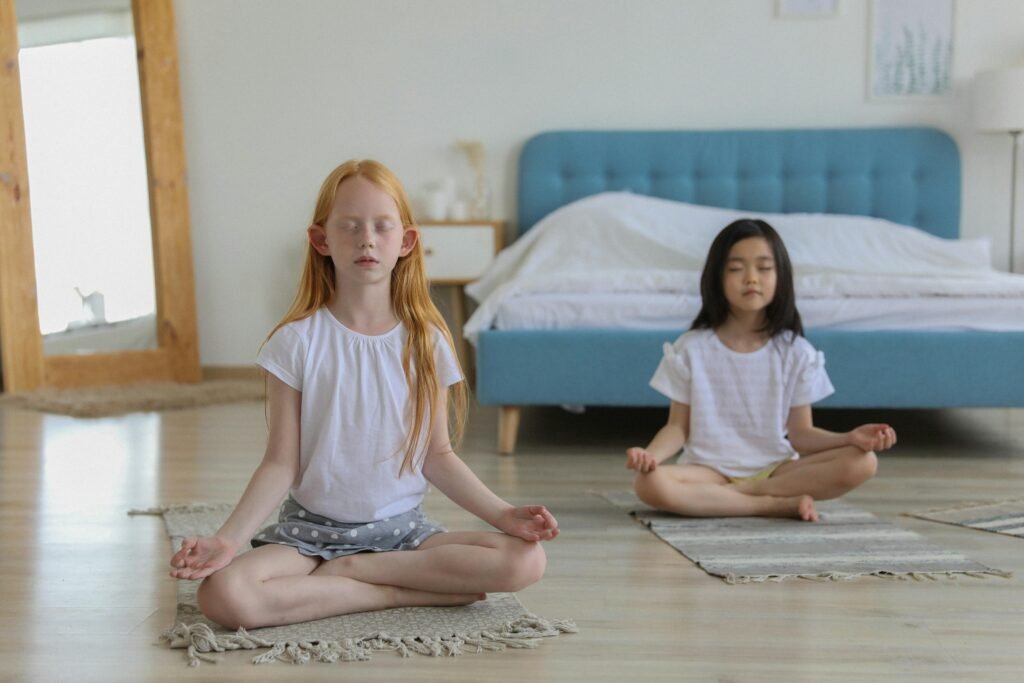Defining Mindfulness in Childhood
Mindfulness is the practice of paying attention to the present moment with curiosity, kindness, and without judgment. While often associated with adults and meditation, mindfulness has emerged as a powerful developmental tool for children, especially during the early years when the brain is rapidly forming connections.
In simple terms, mindfulness helps children notice what’s happening inside and around them, their thoughts, emotions, bodily sensations, and environment, without reacting impulsively. It teaches them to pause, observe, and respond with intention.
Mindfulness in children doesn’t require silence or stillness. It can look like a child taking a deep breath before answering, noticing their heartbeat after running, or simply focusing on how it feels to draw, eat, or play. These seemingly small moments have a big impact on brain development and emotional well-being.
The Science Behind Mindfulness and the Brain
Childhood is a period of intense neurological growth. The brain’s architecture is especially shaped by how children manage stress, attention, and emotion. Mindfulness acts like a gym for the brain, it strengthens the prefrontal cortex, reduces reactivity in the amygdala, and improves connections between emotional and thinking centers.
Research-backed benefits include:
- Increased focus and attention span
- Improved impulse control and self-regulation
- Reduced stress, anxiety, and emotional reactivity
- Strengthened empathy and kindness toward others
- Enhanced sleep quality and overall well-being
When practiced consistently, mindfulness helps children shift from “fight-or-flight” mode to a calmer, more reflective state, laying the foundation for better decision-making, learning, and relationships.
The Role of Environment in Cultivating Mindfulness
Children do not naturally practice mindfulness without guidance. Their environments, especially the adults in their lives, serve as models and mirrors.
Parental Influence
Parents and caregivers are the first mindfulness teachers. Children absorb not only what we say, but how we handle stress, how we breathe through challenges, and how we stay present (or not). By practicing mindfulness ourselves, we create a ripple effect that nurtures emotional awareness in our children.
Mindfulness in the Classroom
More schools are integrating mindfulness through breathing exercises, mindful movement, and emotional check-ins. These simple, consistent practices help students manage anxiety, improve focus, and build classroom empathy. Mindfulness also creates a safe emotional climate for learning.
Cultural and Community Context
Mindfulness is not new, it is rooted in ancient wisdom and practiced across cultures. When mindfulness is taught in ways that honor a child’s cultural identity and language, it becomes not only a tool for regulation, but a path to self-respect and belonging.
Stages of Mindfulness Development in Children
Mindfulness is a skill that grows with time, just like language or emotional intelligence. Here’s how it tends to develop:
- Ages 2–5: Children begin learning to notice emotions and bodily sensations. Mindfulness looks like naming feelings, taking belly breaths, or using a calming object.
- Ages 6–9: Kids start to build awareness of thoughts, practice patience, and reflect on their actions. Mindfulness may show up as listening closely, noticing surroundings, or slowing down before reacting.
- Ages 10–12: Children develop deeper insight. They can practice self-compassion, understand emotional triggers, and use mindfulness for problem-solving and stress management.
Each stage reinforces a child’s emotional regulation, resilience, and mental clarity.
Benefits of Practicing Mindfulness in Childhood
The impact of mindfulness goes far beyond relaxation. When woven into daily life, mindfulness provides tools that empower children in all areas of development:
Academic Success
Mindfulness improves attention span, working memory, and task persistence, helping students stay engaged and perform better in school.
Emotional Intelligence
Children become more skilled at recognizing, naming, and managing their emotions, leading to fewer outbursts and better communication.
Social Skills
Mindful children show greater empathy and cooperation, making them better friends, classmates, and family members.
Mental Health
Mindfulness builds inner calm. Studies show it reduces symptoms of anxiety, depression, and stress, promoting emotional resilience.
Connection and Compassion
Children who practice mindfulness often develop a deeper connection to themselves, others, and the world, laying the foundation for empathy, inclusivity, and compassion.
Why It Matters to Us
At My Mind is Powerful, we believe that mindfulness isn’t a luxury, it’s a lifeline. Especially for bilingual, bicultural children, mindfulness creates a bridge between two worlds, helping them stay grounded in who they are, even when navigating multiple languages, cultures, and expectations.
By offering mindfulness tools in English and Spanish, we empower children to regulate, reflect, and rise, in both languages, and in every space they occupy.
Final Thoughts
In a world full of distractions, noise, and pressure, mindfulness gives children the greatest gift: presence.
When a child learns to slow down, breathe, and notice what’s happening inside, they build emotional muscle that will serve them for a lifetime. The science is clear: mindfulness grows stronger, kinder, and more resilient minds.
Because calm minds are powerful minds. And at My Mind is Powerful, we’re here to nurture both.
